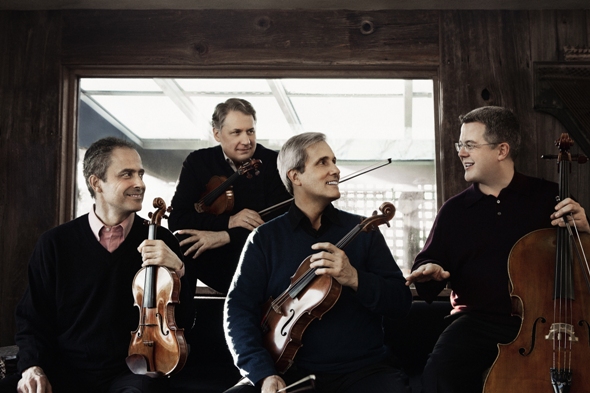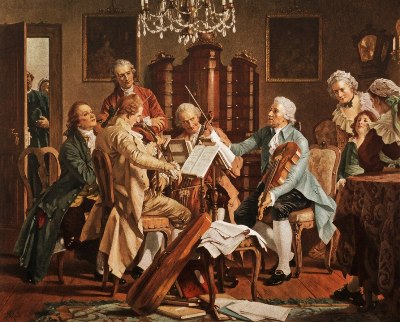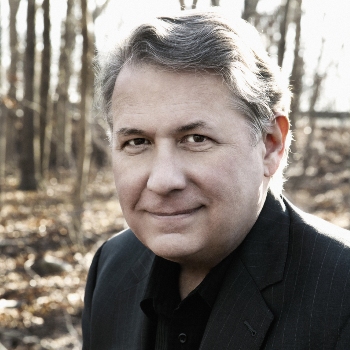Emerson String Quartet to explore late Haydn with one-night immersion at Ravinia Festival
 Preview: Concert July 5 will offer Haydn’s six quartets, Op. 76 – a watershed in his creative life, says Emerson violinist Philip Setzer.
Preview: Concert July 5 will offer Haydn’s six quartets, Op. 76 – a watershed in his creative life, says Emerson violinist Philip Setzer.
By Lawrence B. Johnson
Philip Setzer, founding violinist with the celebrated Emerson String Quartet, calls the sort of program his foursome will play at the Ravina Festival on July 5 a form of biography: a body of works from the hand of a single composer.
In that light, the Emerson’s novel Ravinia project might be called a summing-up chapter in the life of the 18th-century Austrian master Joseph Haydn. At one sitting (allowing for two intermissions), Setzer and his companions will play all six of the string quartets collectively published in 1799 as Haydn’s Op. 76. The Emerson will repeat its Op. 76 survey at Tanglewood in the Massachusetts Berkshires on July 12.
 While Haydn, the most revered composer in Europe through the last decades of the 18th century, earned much of his fame as “father of the symphony,” connoisseurs have always held his prodigious body of string quartets in equally high regard. So deeply did Mozart, 24 years Haydn’s junior, admire the older composer’s quartets that he famously dedicated six of his own works in the form to Haydn.
While Haydn, the most revered composer in Europe through the last decades of the 18th century, earned much of his fame as “father of the symphony,” connoisseurs have always held his prodigious body of string quartets in equally high regard. So deeply did Mozart, 24 years Haydn’s junior, admire the older composer’s quartets that he famously dedicated six of his own works in the form to Haydn.
Still, it is unusual in our own time for an ensemble to consecrate an extended evening to the quartets of Haydn – though not uncommon at all to devote such an undertaking to, say, the six string quartets of Bartók or the late quartets of Beethoven. But Setzer says the Haydn Op. 76 quartets hold a special place in the composer’s artistic life and – for musicians and listeners alike – pay rich dividends in such an immersion.
“I think Haydn felt he had something to prove when he set out to write these quartets,” says Setzer. “He had just returned to Vienna from his second extended visit to London, where he was treated like royalty and where his last 12 symphonies were all given their premieres. But this time, in 1795, he came home to Vienna to find a somewhat changed situation.
“Mozart, who had died just four years earlier, was now being played everywhere, and Beethoven was the new kid on the block (age 25 and lionized as a piano virtuoso). Haydn surely sensed the need to reaffirm his own creative powers, and the new quartets he wrote over the next several months absolutely achieved that.”
Haydn was now 63 years old. From an early age, he had explored, stretched, essentially invented and then reshaped the string quartet, much as he did simultaneously with the symphony. The six pieces that came into the world as his Op. 76, says Setzer, once again took the string quartet to a new place.
 “Haydn was looking for ways to expand sonata form (thematic exposition, development and modified restatement). Beethoven would pursue the same end in his three Op. 59 quartets, but those pieces are twice as long as Haydn’s quartets, which offer six highly individual displays of concentration and invention.”
“Haydn was looking for ways to expand sonata form (thematic exposition, development and modified restatement). Beethoven would pursue the same end in his three Op. 59 quartets, but those pieces are twice as long as Haydn’s quartets, which offer six highly individual displays of concentration and invention.”
At the same time, says Setzer, Haydn the lifelong musical jokester may have been in his seventh decade but his enthusiasm for sparking a good laugh was undiminished. For Haydn, it was the minuet – typically occurring third in the quartet’s four-movement plan – that provided the occasion for mirth.
“By the time Haydn gets to Op. 76, his minuets are not what we would call dances,” says the violinist. “He still doesn’t use the term scherzo (Italian for ‘I joke’ or ‘I jest’), which Beethoven soon would prefer, but the humorous edge is always there. How do you indicate ‘presto’ and call it a minuet?”
Perhaps the most famous non-minuet of these quartets is the driving, heavy-footed dance of Op. 76, No. 2, known as the “minuetto delle streghe” (the witches’ minuet). Witty turns, however, do not define the greatness of these ambitious quartets. Their ultimate majesty, notes Setzer, resides in their quieter episodes.
 “The six slow movements go beyond anything in his earlier quartets or anything else. The innovation is extraordinary, the constant playing with musical ideas, finding ways to deepen it. You don’t think of Haydn – Papa Haydn as he was affectionately known — as being in touch with tragedy. But when you read about his life, you find a lot of sadness in it.
“The six slow movements go beyond anything in his earlier quartets or anything else. The innovation is extraordinary, the constant playing with musical ideas, finding ways to deepen it. You don’t think of Haydn – Papa Haydn as he was affectionately known — as being in touch with tragedy. But when you read about his life, you find a lot of sadness in it.
“And he adored Mozart. He had tried very hard to arrange for Mozart to come to London, but then Mozart became ill and it never worked out. Now here was Haydn back in Vienna and Mozart was gone. In these slow movements, I think you hear something of the heaviness in the aging composer’s heart.”
Related Links:
- Official website of the Ravinia Festival: Ravinia.org
- Preview of the complete 2016 Ravinia Festival: Read it at ChicagoOntheAisle.com
Tags: Emerson String Quartet, Joseph Haydn, Ravinia Festival

